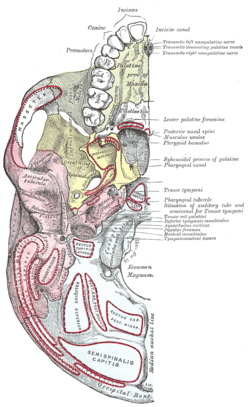Occipital condyles
| Occipital condyles | |
|---|---|
 Occipital bone. Outer surface. Occipital condyles are indicated by yellow arrows. | |
 Occipital bone. Outer surface. (Condyle for artic. with atlas labeled at lower left.) | |
| Details | |
| Identifiers | |
| Latin | Condylus occipitalis |
| TA | A02.1.04.014 |
| FMA | 52861 |
The occipital condyles are undersurface protuberances of the occipital bone in vertebrates, which function in articulation with the superior facets of the atlas vertebra.
The condyles are oval or reniform (kidney-shaped) in shape, and their anterior extremities, directed forward and medialward, are closer together than their posterior, and encroach on the basilar portion of the bone; the posterior extremities extend back to the level of the middle of the foramen magnum.
The articular surfaces of the condyles are convex from before backward and from side to side, and look downward and lateralward.
To their margins are attached the capsules of the atlanto-occipital joints, and on the medial side of each is a rough impression or tubercle for the alar ligament.
At the base of either condyle the bone is tunnelled by a short canal, the hypoglossal canal.
Additional images
 Position of occipital condyles (shown in red)
Position of occipital condyles (shown in red) Skull and cervical vertebra. Occipital condyles (red) articulate with the superior facets of the atlas.
Skull and cervical vertebra. Occipital condyles (red) articulate with the superior facets of the atlas. Base of skull. Inferior surface.
Base of skull. Inferior surface.- Occipital condyles
In dinosaurs
The occipital condyle is a rounded projection that is present on the posterior (bottom) of the dinosaur's skull. It articulates with the first cervical (neck) vertebra and, in effect, attaches the head of the dinosaur to its body. Functionally it allows the head to move from side to side, up and down, as well as to rotate. A combination of a number of smaller bones (such as the basioccipital and exoccipitals) participate in the formation of this structure. The presence of a single occipital condyle in dinosaurs, crocodilians and birds is contrasted with the condition in synapsids, amphibians, and mammals including Homo sapiens, where two occipital condyles are present. In most dinosaurs the occipital condyle is situated at the rear part of the skull, below the foramen magnum, and points toward the posterior of the animal. Some exceptions to this exist, such as in the iguanodontian Anabisetia saldiviai where the condyle points downward. In some dinosaurs, where the skull was not preserved, the presence of a small occipital condyle suggests to some paleontologists that the skull of the dinosaur was relatively small.
See also
References
This article incorporates text in the public domain from the 20th edition of Gray's Anatomy (1918)
Further reading
- Anderson PA, Montesano PX (July 1988). "Morphology and treatment of occipital condyle fractures". Spine. 13 (7): 731–6. doi:10.1097/00007632-198807000-00004. PMID 3194779.
- Nanda A, Vincent DA, Vannemreddy PS, Baskaya MK, Chanda A (February 2002). "Far-lateral approach to intradural lesions of the foramen magnum without resection of the occipital condyle". Journal of Neurosurgery. 96 (2): 302–9. doi:10.3171/jns.2002.96.2.0302. PMID 11841072.
- Bloom AI, Neeman Z, Slasky BS, et al. (March 1997). "Fracture of the occipital condyles and associated craniocervical ligament injury: incidence, CT imaging and implications". Clinical Radiology. 52 (3): 198–202. doi:10.1016/s0009-9260(97)80273-5. PMID 9091254.
- Tuli S, Tator CH, Fehlings MG, Mackay M (August 1997). "Occipital condyle fractures". Neurosurgery. 41 (2): 368–76; discussion 376–7. doi:10.1097/00006123-199708000-00006. PMID 9257304.
- Orbay T, Aykol S, Seçkin Z, Ergün R (May 1989). "Late hypoglossal nerve palsy following fracture of the occipital condyle". Surgical Neurology. 31 (5): 402–4. doi:10.1016/0090-3019(89)90076-1. PMID 2711317.
- Bolender N, Cromwell LD, Wendling L (October 1978). "Fracture of the occipital condyle". American Journal of Roentgenology. 131 (4): 729–31. doi:10.2214/ajr.131.4.729. PMID 102174.
- Vishteh AG, Crawford NR, Melton MS, Spetzler RF, Sonntag VK, Dickman CA (January 1999). "Stability of the craniovertebral junction after unilateral occipital condyle resection: a biomechanical study". Journal of Neurosurgery. 90 (1 Suppl): 91–8. doi:10.3171/spi.1999.90.1.0091. PMID 10413132.
- Clayman DA, Sykes CH, Vines FS (August 1994). "Occipital condyle fractures: clinical presentation and radiologic detection". American Journal of Neuroradiology. 15 (7): 1309–15. PMID 7976943.
- Young WF, Rosenwasser RH, Getch C, Jallo J (February 1994). "Diagnosis and management of occipital condyle fractures". Neurosurgery. 34 (2): 257–60; discussion 260–1. doi:10.1097/00006123-199402000-00008. PMID 8177386.
- Spencer JA, Yeakley JW, Kaufman HH (July 1984). "Fracture of the occipital condyle". Neurosurgery. 15 (1): 101–3. doi:10.1097/00006123-198407000-00018. PMID 6472584.
External links
| Wikimedia Commons has media related to Occipital condyles. |
- lesson9 at The Anatomy Lesson by Wesley Norman (Georgetown University)
- Anatomy diagram: 34256.000-2 at Roche Lexicon - illustrated navigator, Elsevier
- Anatomy diagram: 34257.000-1 at Roche Lexicon - illustrated navigator, Elsevier
- occipital condyles on Triceratops